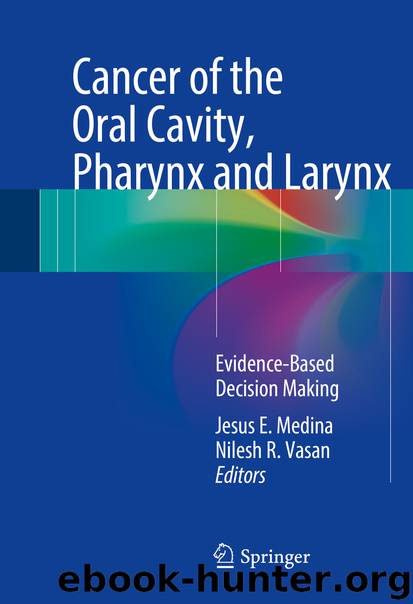Cancer of the Oral Cavity, Pharynx and Larynx by Jesus E. Medina & Nilesh R. Vasan

Author:Jesus E. Medina & Nilesh R. Vasan
Language: eng
Format: epub
Publisher: Springer International Publishing, Cham
Recurrence at the Primary Site
Approximately 10 % of NPC patients will at some point have residual disease identified in the nasopharynx. The clinician must properly counsel these patients on their treatment options and must be candid with them about the specific risks associated with treatment in a setting of prior radiation therapy.
There are two generally accepted methods for treating residual/recurrent disease at the primary site: re-irradiation or endoscopic nasopharyngectomy. At select high-volume sites one might consider additional open approaches that could be offered to patients with more extensive disease; however as a general rule surgical treatment via endoscopic techniques is reserved only for patients that are limited to the nasopharyngeal cavity, the postnaris or nasal septum, the superficial parapharyngeal space, or the base wall of the sphenoid sinus. A case-matched comparisons with 72 patients in each group evaluated the endoscopic technique compared to IMRT and they reported equivalent local–regional control between the two groups. They did however note several differences in quality of life and complications where endoscopic nasopharyngectomy was better tolerated in longer term evaluation [3]. While this is promising the limitations in terms of the extent of disease amenable to endoscopic resection will limit its overall use.
Re-irradiation with IMRT has broader application as it is not limited to the surgical shell boundaries; however patients must be well informed of the potential complications associated with it. In the prior study comparing surgery with re-irradiation it is interesting to note that of the 53 patients who died during the study period, 29 (54 %) died of treatment-related complications while only 37 % succumbed to disease progression. The most common complication that resulted in death was nasopharyngeal necrosis and subsequent hemorrhage followed by necrosis of the temporal lobe. A number of patients suffered significant morbidity from xerostomia, hearing loss/deafness, trismus, and cachexia and while not mentioned in their report, there is a significant risk for visual loss as well depending on the location of the residual disease. That said the overall survival at 5 years was 40–60 % for the two techniques [3].
Download
This site does not store any files on its server. We only index and link to content provided by other sites. Please contact the content providers to delete copyright contents if any and email us, we'll remove relevant links or contents immediately.
| Anesthesiology | Colon & Rectal |
| General Surgery | Laparoscopic & Robotic |
| Neurosurgery | Ophthalmology |
| Oral & Maxillofacial | Orthopedics |
| Otolaryngology | Plastic |
| Thoracic & Vascular | Transplants |
| Trauma |
Periodization Training for Sports by Tudor Bompa(8215)
Why We Sleep: Unlocking the Power of Sleep and Dreams by Matthew Walker(6659)
Paper Towns by Green John(5141)
The Immortal Life of Henrietta Lacks by Rebecca Skloot(4552)
The Sports Rules Book by Human Kinetics(4348)
Dynamic Alignment Through Imagery by Eric Franklin(4179)
ACSM's Complete Guide to Fitness & Health by ACSM(4021)
Kaplan MCAT Organic Chemistry Review: Created for MCAT 2015 (Kaplan Test Prep) by Kaplan(3972)
Introduction to Kinesiology by Shirl J. Hoffman(3744)
Livewired by David Eagleman(3730)
The Death of the Heart by Elizabeth Bowen(3581)
The River of Consciousness by Oliver Sacks(3574)
Alchemy and Alchemists by C. J. S. Thompson(3484)
Bad Pharma by Ben Goldacre(3397)
Descartes' Error by Antonio Damasio(3250)
The Emperor of All Maladies: A Biography of Cancer by Siddhartha Mukherjee(3114)
The Gene: An Intimate History by Siddhartha Mukherjee(3075)
The Fate of Rome: Climate, Disease, and the End of an Empire (The Princeton History of the Ancient World) by Kyle Harper(3035)
Kaplan MCAT Behavioral Sciences Review: Created for MCAT 2015 (Kaplan Test Prep) by Kaplan(2960)
